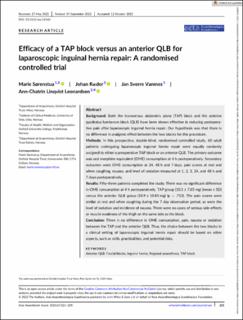| dc.description.abstract | Background
Both the transversus abdominis plane (TAP) block and the anterior quadratus lumborum block (QLB) have been shown effective in reducing postoperative pain after laparoscopic inguinal hernia repair. Our hypothesis was that there is no difference in analgesic effect between the two blocks for this procedure.
Methods
In this prospective, double-blind, randomised controlled study, 60 adult patients undergoing laparoscopic inguinal hernia repair were equally randomly assigned to either a preoperative TAP block or an anterior QLB. The primary outcome was oral morphine equivalent (OME) consumption at 4 h postoperatively. Secondary outcomes were OME consumption at 24, 48 h and 7 days, pain scores at rest and when coughing, nausea, and level of sedation measured at 1, 2, 3, 24, and 48 h and 7 days postoperatively.
Results
Fifty-three patients completed the study. There was no significant difference in OME consumption at 4 h postoperatively, TAP group (10.3 ± 7.85 mg) (mean ± SD) versus the anterior QLB group (10.9 ± 10.85 mg) (p = .713). The pain scores were similar at rest and when coughing during the 7 day observation period, as were the level of sedation and incidence of nausea. There were no cases of serious side-effects or muscle weakness of the thigh on the same side as the block.
Conclusion
There is no difference in OME consumption, pain, nausea or sedation between the TAP and the anterior QLB. Thus, the choice between the two blocks in a clinical setting of laparoscopic inguinal hernia repair should be based on other aspects, such as skills, practicalities, and potential risks. | en_US |

